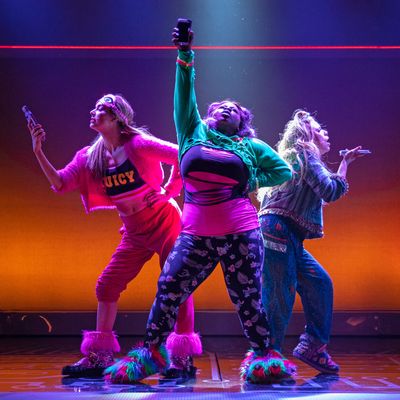
The American musical loves high school. And vice versa: They go together like rama-lama-lama-ka-dinga-da-dinga-dong. Maybe it’s because most people who make musicals spent high school at best keeping a low profile and at worst running for their lives, and what better way to exorcise demons than with a fierce vibrato and a flawless step-ball-change? Or maybe because in high school the stakes are just naturally high all the frickin’ time. There’s a reason Romeo and Juliet is about teenagers, and there’s a reason West Side Story took it from there. When every facet of your reality feels like a matter of life and death, when you’re convinced that your exploding skin and metamorphosing body portend the imminent earthly arrival of the id-fueled werebeast that lurks inside of you, when you’re all like OMG SMH FML 😭😭😭😱💔😡😬💩😰💦💀 — how much of a leap is it to just start singing?
The zippy, delightfully devilish Be More Chill is the latest tale of teen angst to convert crippling self-doubt and frustrated desire into the sound of music, and the results are enjoyable not just for their energy and charm but also for the streak of knowing wickedness running through all the pop and fizz. With high-octane music and lyrics by Joe Iconis and a smartly tailored book by Joe Tracz — kept clipping vivaciously along by director Stephen Brackett — Be More Chill has a welcome edge of nastiness to it, a hint of Little Shop of Horrors acidity that’s refreshing in a world full of Superheros. While it’s pretty clear that we’re headed for a triumphant finish, where people learn things and get nicer to each other, the story’s also got a weather eye on the real cruelties of youth, and on the way graduating from high school doesn’t mean graduating from our insecurities.
The bulk of those insecurities here belong to Jeremy (Will Roland), a bespectacled junior who doesn’t “wanna be a hero … I just wanna survive.” Jeremy navigates the perils of the social pecking order with his best friend Michael, a bouncy nerd who’s obsessed with all things “retro” (i.e., all things ’90s: He gets jazzed about scoring expired bottles of Crystal Pepsi on eBay) and whom the sweet-voiced George Salazar brings to super-lovable, scene-stealing life. But despite the support of a loyal friend — expressed in the catchy fistpumper “Two-Player Game” — Jeremy’s still suffering. His recently divorced dad (Jason SweetTooth Williams, gamely playing the show’s token adults) never puts on pants, the school bully (Gerard Canonico) torments him and the popular kids snub him, and he’s got a throbbing unrequited crush on Christine Canigula (Stephanie Hsu), a true rara avis — with neon leggings and sparkly Doc Martens and an all-consuming love of theater — who barely knows he’s alive.
Enter the SQUIP. That’s short for “Super Quantum Unit Intel Processor.” (“It’s from Japan,” we’re informed repeatedly, in mystical tones pregnant with hilariously vague implication.) Basically, it’s a pill that helps you be cool. No, not cool — as the magnificent Jason Tam, playing the sleek human embodiment of this megalomaniacal nanotechnology informs Jeremy sharply — but chill. After all, what cool person uses the word cool? Duh.
After an unexpected tip-off from Rich, the bully, Jeremy scores his SQUIP from a creepy stock-boy at the local Payless (also Williams), and is soon on the path to popularity, guided by the tiny computer now lodged in his brain. Be More Chill isn’t about shocking twists: The SQUIP’s ulterior ravenous menace is as initially apparent as Audrey II’s, and the plot’s developments — from Jeremy’s craven abandonment of Michael to his series of failures, despite being SQUIP-equipped, with Christine — are easy to see coming. But like many good musicals, the show is canny and sassy about its use of formula, soaring on the strength of its witty, amped-up tunes, its moments of sly perception, and its bang-up performances. Roland has just the right combination of nerd vibes and killer voice for Jeremy, and the impressive Tiffany Mann is belting the pants off her role as Jenna Rolan, the needy school gossip. She reigns supreme over a song that tips its hat to Bye Bye Birdie, in which juicy info is spread like wildfire via smartphone.
Meanwhile Tam is reveling in glorious villain-mode as the SQUIP, strutting his stuff in a fantastic series of silvery sci-fi robes by Bobby Frederick Tilley II. Every time he upgrades, his insidious power growing, he gets a new costume: He’s like the nefarious nanobot offspring of Cher and Ming the Merciless, and Tam isn’t just singing the house down — he’s also doing an extremely funny Keanu Reeves impression. “My default mode,” he explains to Jeremy, his voice dripping with SoCal nonchalance. But he can take any form his helpless human host finds most attractive: “Batman. Beyoncé. A sexy anime cat girl with a tail.”
One of Be More Chill’s shrewdest bits of comedy comes when the SQUIP encounters Christine for the first time. Hsu — who recently finished playing her own very funny computer in SpongeBob SquarePants — is a total powerhouse in the role, released, passionately wacky, and the play’s bubbly, indefatigable truth-teller. “There just aren’t strong roles for women in the theater these days, particularly high school theater, do you find that? Because I totally find that!” she buzzes breathlessly to Jeremy during “I Love Play Rehearsal,” adding (perhaps too relatably for some of us), “I have mad, gigantic feelings / Rad and frantic feelings / About mostly everything — / Like gun control! Like spring!”
Even as a hyper, scattered teenager, Christine’s such a full person — the makings of someone with so much actual passion and integrity — that of course the SQUIP doesn’t know what to make of her. “This one is interesting,” the bot muses to Jeremy with an edge of distrust in its silky voice. “The way she talks. The way she carries herself. She doesn’t seem to care what anyone thinks … It’s highly unusual.” In the grand tradition of technophobia sci-fi, humanity is the bug. It’s our eccentricities and vulnerabilities that will save us, and they do not compute.
Be More Chill has a lot of fun with genre tropes, from the spooky theremin that starts the show (the techno-tinged, power-emo orchestrations are by Charlie Rosen, with music direction by Emily Marshall) to the drunken, no-parents-around Halloween house party that starts in Act 2. Though Mean Girls still takes the cake for wittiest number currently on a Broadway stage skewering sexy costume trends, Be More Chill is definitely a contender for best affectionate mockery of a school play. Jeremy’s journey reaches its climax during a performance of A Midsummer Night’s Dream, which the Hot Pocket-addicted drama teacher (also also Williams) has adapted into A Midsummer Night-MARE. It’s set in a post-apocalyptic future. With zombies, not fairies. (The spirit of Corky St. Clair is alive and well and teaching high school in New Jersey. And he’s got a truly suspension-of-disbelief-defying costume hook-up because the kids look like glittery descendants of Stan Lee and RuPaul.) Drama nerds know the power of a good play within a play, and it’s a treat to watch the chaos of Be More Chill — a show about human idiots bewitched by magical technology — merge with the chaos of Midsummer, a show about human idiots bewitched by a magical flower. It’s also a delight to listen to Tam reach the height of his diabolical powers in “The Pitiful Children,” and to see Chase Brock drive full force into the video game influences in the show’s choreography. There’s a cheeky, open-eyed quality to Be More Chill that knows better than to spill over into archness — because musicals aren’t actually chill at all, ever. And no one sums up this mixture of sincerity and worldly mischief better than Christine, who, when things look bleakest, delivers a distressed zinger that might just qualify for best self-own of the current theatrical moment: “I look around and everyone’s hurting. I wish there was something real I could do to make things better but I don’t know how. So I guess I’ll just do theater.” How do the kids put it? I feel so seen.
Be More Chill is at the Lyceum Theatre. Buy tickets here.
*A version of this article appears in the March 18, 2019, issue of New York Magazine. Subscribe Now!


